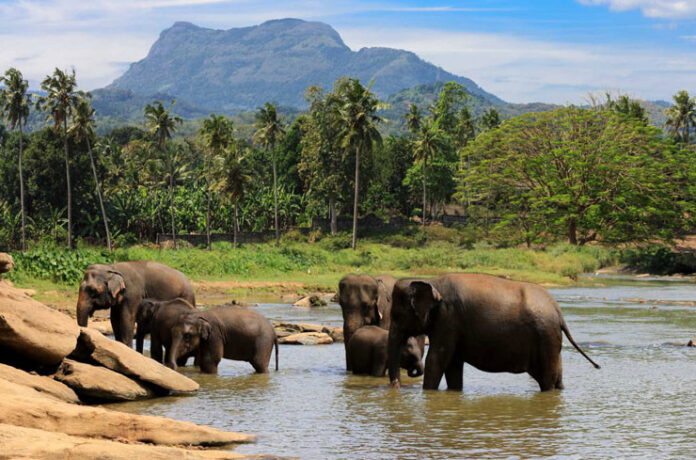There’s no question that sustainable tourism can help revive a battered economy. I’ve seen it happen time and time again in my work as a sustainability consultant. But what does that mean for communities on the ground? When tourism is managed sustainably, it can have a positive impact on the environment, social welfare, and economy of a destination.
It’s no secret that Sri Lanka has faced some major challenges in recent years. The civil war that ended in 2009 left the country deeply divided, the devastating tsunami of 2004 destroyed vast areas of the coastal landscape, and the present 2019 Sri Lankan economic crisis badly affected the tourist trade. In the years since the country has been working to rebuild—but it’s been an uphill battle. There is hope, though. In 2015, Sri Lanka was declared a “Sustainable Tourism Destination” by the United Nations World Tourism Organisation (UNWTO), and tourism is now being touted as a
key to restoring the economy. I had the opportunity to visit Sri Lanka in 2021 and 2022 and see these efforts firsthand. I was blown away by the natural beauty of the country and its rich cultural heritage. And I was impressed by how local communities are benefiting from tourism development. In this article, I share my impressions of Sri Lanka and explore some of how sustainable tourism can help rebuild the economy.
Overview of Sri Lanka’s Tourism Industry
Sri Lanka’s tourism industry is a vital part of its economy, and it has been hit hard by the economic instability that has been raging for years. In the past, the country has leaned heavily on the tourism industry to bring in revenue, but with the political unrest keeping people away, that is no longer the case. However, there is hope that sustainable tourism can save the day. Sustainable tourism is defined as “tourism that does not have a negative impact on the environment or local culture.” This type of tourism is becoming more popular as people become more aware of the need to protect our planet. There are many ways to promote sustainable tourism, and Sri Lanka has already begun to implement some of them. For example, the government has set up a program to certify hotels and restaurants that meet certain environmental standards. This program is helping to encourage hotels and restaurants to adopt sustainable practices.
History and Impact of Sustainable Tourism in Sri Lanka
Sustainable tourism has been around for a while, but it seems to have taken on a new urgency in the past decade or so. With the world’s population continuing to grow, the strain on our natural resources is becoming more and more apparent. At the same time, people are becoming more and more aware of the need to protect our environment. Sustainable tourism is one way to meet both of these needs. It’s a way for us to enjoy the natural beauty of our planet while ensuring that it remains accessible for future generations. Sri Lanka provides a perfect example of how this can work. For years, the country has depended on tourism as its main source of income. But with the rise of civil war and political unrest, the industry was hit hard. In recent years, however, there has been a concerted effort to revive sustainable tourism in Sri Lanka. And it seems to be working.
Benefits of Sustainable Tourism for the Economy
There’s no question that sustainable tourism can help revive a battered economy. I’ve seen it happen time and time again in my work as a sustainability consultant. But what does that mean for communities on the ground? When tourism is managed sustainably, it can have a positive impact on the environment, social welfare, and economy of a destination. For Sri Lanka, this could mean restored beaches and coral reefs, thriving local businesses, and more job opportunities for the people of Sri Lanka. It’s an exciting prospect, and I can’t wait to see the positive impact that sustainable tourism will have on this beautiful country.
Challenges to Implementing Sustainable Tourism in Sri Lanka
Sri Lanka is not without its challenges when it comes to encouraging sustainable tourism. It may be difficult to ensure that tourists are following environmental regulations, as many don’t always know the basic rules and regulations or even could be breaking them unaware. In addition, there is a need to establish adequate infrastructure to make sure that mass tourism attracted will not have a negative impact on the environment, such as proper sanitation and waste disposal. The country needs to create more awareness and education regarding sustainable tourism among its people, so they can appreciate its importance and work together to protect their environment. There needs to be more environmental projects and initiatives
implemented as well for sustainable tourism efforts to be successful. Finally, there needs to be proactive steps taken by local businesses and government officials for sustainable tourism efforts to take root in Sri Lanka.
How to Make Sustainable Tourism Work in Sri Lanka
Sustainable tourism is a great way to fuel a country’s economy, but there are still many challenges that must be overcome. For example, the infrastructure in Sri Lanka has been damaged due to years of war and natural disasters, making it difficult to attract tourists. To make sustainable tourism work in Sri Lanka, there needs to be more investment and funding. The government could invest in hotels and restaurants, transportation systems and other infrastructure that would attract tourists.
Additionally, Sri Lanka needs to make sure that their tourism industry is as low-impact as possible by minimising waste production, limiting water usage and preserving wildlife habitats. Finally, there should be efforts taken to ensure that locally-owned businesses benefit from the influx of tourists instead of large multinational corporations or international hotel chains. Locals need to be trained for jobs related to tourism, such as tour guides, hotel staff or restaurant workers. This will help create long-term employment opportunities for the people living in Sri Lanka and allow them to take advantage of the growing tourism market.
Measuring the Impact of Sustainable Tourism in Sri Lanka
Measuring the impact of sustainable tourism in Sri Lanka is tricky. A realistic approach needs to be taken and a comprehensive assessment of the tourism industry should be conducted, including areas such as employment, return on investment and environmental protection. The Sri Lankan government has implemented several initiatives to stimulate the industry and boost investment, including tax incentives for businesses and increased marketing and promotional activities. However, these efforts have been hampered by limited resources and a lack of coordination between relevant government departments responsible for formulating policies. It is also important to assess the sustainability of the tourist destinations in Sri Lanka, as well as their contribution to socio-economic development.
For example, whether tourists spend money within local communities or whether there are any conflicts between locals and tourists. Measuring these impacts is key to understanding how tourism can foster economic growth and create lasting positive change in Sri Lanka. There is no one-size-fits-all answer to this question. Each destination has its unique challenges and opportunities. However, by understanding the benefits and challenges of sustainable tourism, Sri Lankan authorities can create a plan that will help to restore the economy while preserving the natural and cultural
heritage of the country.










